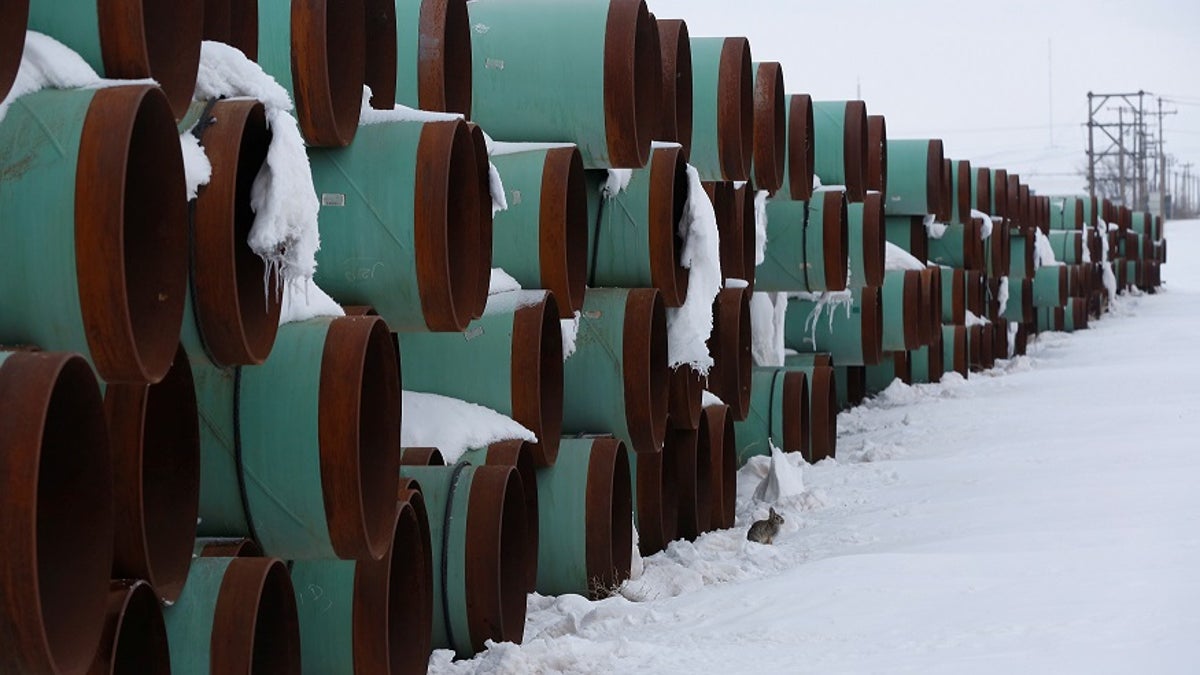
A depot used to store pipes for Transcanada Corp's planned Keystone XL oil pipeline is seen in Gascoyne, North Dakota, January 25, 2017. REUTERS/Terray Sylvester - RC199BCF1600
President Trump’s first State of the Union speech Tuesday night is a prime opportunity to put infrastructure front and center in his domestic agenda. For the sake of our nation’s economic prosperity and national security, the president should emphasize the potential of clean energy infrastructure.
Upgrading our nation’s crumbling infrastructure was a consistent theme for candidate Trump during his campaign for the presidency. He included the American Energy and Infrastructure Act in his contract with the American voter. The idea was simple as it was bold: to leverage public-private partnerships and private investments through tax incentives to spur infrastructure investment.
America’s electric grid and natural gas system have fueled decades of economic growth. They have helped to strengthen our international competitiveness by assuring that American businesses have access to affordable, reliable electricity. However, our infrastructure lacks key attributes needed to meet the demands of a digitally driven economy.
Investing in clean energy innovation and development isn’t just an opportunity, it’s a necessity. Most electric transmission and distribution lines were constructed in the 1950s and 1960s with a 50-year life expectancy. In addition, the more than 640,000 miles of high-voltage transmission lines are at full capacity.
Countless miles of pipe and cable need to be replaced over the next several years. The American Society of Civil Engineers estimates that the cumulative investment gap between now and 2025 is $177 billion. This additional funding will be needed to assure that our electricity generation, transmission and distribution infrastructure is adequate.
By reasserting the promise of the “American Energy and Infrastructure Act,” President Trump will do more than honor a campaign promise. He can set our nation on a course to achieve the economic, energy and national security needs his predecessors only dreamed about.
Many infrastructure projects can be aligned with our energy production needs. This is especially important for economic development in rural America. More efficient generating equipment can be brought to existing facilities, and it is possible to add generating capacity to infrastructure that has none today.
For example, only 3 percent of our nation’s 80,000 aging dams generate electricity. But dams can be retrofitted for hydropower to provide affordable electricity and create much-needed jobs across rural America. And with emerging technologies, infrastructure such as transportation and irrigation canals, drinking water systems and wastewater systems can be retrofitted for power generation as well.
As the Trump administration and Congress consider options and actions to invest in America’s infrastructure, the following four key recommendations can capture a once-in-a-generation opportunity to aggressively integrate clean energy into the grid, facilitate the addition of energy storage technology, and jumpstart the appropriate use of micro-grids. Doing so will establish a crucial foundation for decades of strong economic growth.
First, clean energy must be established as a strategic priority. With the help of federal investment, utilities, states and municipalities stand to lower their costs and increase economic development. Furthermore, looking at water and transportation projects with an eye on energy generation or energy efficiency can help make the project or investment more economically viable or profitable.
Second, the infrastructure bill must maximize public-private partnerships to leverage the private sector and make the most of each taxpayer dollar.
Third, instead of focusing on an arbitrary definition of “shovel-ready” projects, federal efforts should identify means for streamlined permit reviews and promote early environmental impact assessments for compliance with the National Environmental Policy Act.
Finally, funding mechanisms should be consolidated and streamlined, and states should be empowered to administer federal funds. It is currently difficult and costly to navigate the numerous funding authorities and mechanisms, ultimately limiting the potential use of public funds. Federal programs should defer to state decision-makers and focus on outcomes to increase accountability and autonomy.
The State of the Union is an annual opportunity for the president to seize the national spotlight and drive a substantive agenda. By reasserting the promise of the “American Energy and Infrastructure Act,” President Trump will do more than honor a campaign promise. He can set our nation on a course to achieve the economic, energy and national security needs his predecessors only dreamed about.
